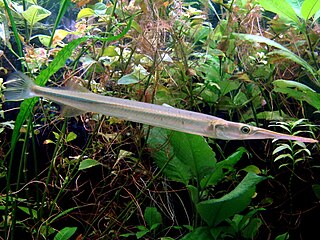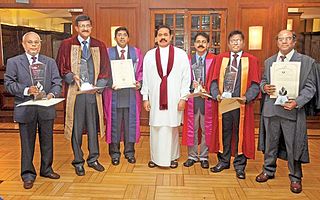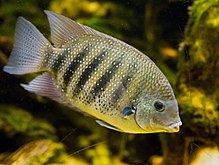
Cichlids are fish from the family Cichlidae in the order Cichliformes. Traditionally Cichlids were classed in a suborder, the Labroidei, along with the wrasses (Labridae), in the order Perciformes, but molecular studies have contradicted this grouping. On the basis of fossil evidence, it first appeared in Tanzania during the Eocene epoch, about 46–45 million years ago. The closest living relative of cichlids is probably the convict blenny, and both families are classified in the 5th edition of Fishes of the World as the two families in the Cichliformes, part of the subseries Ovalentaria. This family is large, diverse, and widely dispersed. At least 1,650 species have been scientifically described, making it one of the largest vertebrate families. New species are discovered annually, and many species remain undescribed. The actual number of species is therefore unknown, with estimates varying between 2,000 and 3,000.
Indian cuisine consists of a variety of regional and traditional cuisines native to the Indian subcontinent. Given the diversity in soil, climate, culture, ethnic groups, and occupations, these cuisines vary substantially and use locally available spices, herbs, vegetables, and fruits.

Roe or hard roe is the fully ripe internal egg masses in the ovaries, or the released external egg masses, of fish and certain marine animals such as shrimp, scallop, sea urchins and squid. As a seafood, roe is used both as a cooked ingredient in many dishes, and as a raw ingredient for delicacies such as caviar.

Harpadon nehereus, is a species of lizardfish. Adults may reach a maximum length of 40 cm (16 in), but the usual size is around 25 cm (10 in).
Indo-Pacific king mackerel, also known as the spotted seer fish or spotted Spanish mackerel, is a sea fish among the mackerel variety of fishes. It is found in around the Indian Ocean and adjoining seas. It is a popular game fish, growing up to 45 kg (99 lb), and is a strong fighter that has on occasion been seen to leap out of the water when hooked.

The Thamirabarani or Tamraparni or Porunai is a perennial river that originates from the Agastyarkoodam peak of Pothigai hills of the Western Ghats, above Papanasam in the Ambasamudram taluk. It flows through Tirunelveli and Thoothukudi districts of the Tamil Nadu state of southern India into the Gulf of Mannar. It was called the Tamraparni River in the pre-classical period, a name it lent to the island of Sri Lanka. The old Tamil name of the river is Porunai. From the source to sea, the river is about 128 kilometres (80 mi) long and is the only perennial river in Tamil Nadu. This river flows towards north direction initially. However, it changes to east direction later.

Channa striata, the striped snakehead, is a species of snakehead fish. It is also known as the common snakehead, chevron snakehead, or snakehead murrel and generally referred simply as mudfish. It is native to South and Southeast Asia, and has been introduced to some Pacific Islands. Reports from Madagascar and Hawaii are misidentifications of C. maculata.

Xenentodon cancila, the freshwater garfish, is a species of needlefish found in freshwater and brackish habitats in South and Southeast Asia.

Mangalavanam is an ecologically sensitive area situated at the centre of the Indian city of Kochi, covering about 2.74 hectares. It also houses a shallow tidal lake connected with Kochi backwaters by a canal. It is situated behind the Kerala High Court building. It is a nesting ground for a large variety of migratory birds and supports many types of mangroves. The Managalavanam is often regarded as the "green lung of Kochi", considering its role in keeping the city's air pollution under check. The area is a roosting place for many kinds of resident and migratory birds.

Etroplus is a small genus of cichlids native to southern India and Sri Lanka. Together with Pseudetroplus, they are the only cichlids of this region.

Pakhaḷa is an Odia cuisine, consisting of cooked rice washed or lightly fermented in water. The liquid part of the dish is known as Toraṇi. It is popular in the state of Odisha and its similar in the eastern regions like Jharkhand the northeastern states of Assam.

Sasthamcotta Lake or Sasthamkotta Lake, also categorized as a wetland, is the largest fresh water lake in Kerala, a state of India on the south of the West Coast. The lake is named after the ancient Sastha temple located on its bank. It meets the drinking water needs of half million people of the Quilon district and also provides fishing resources. The purity of the lake water for drinking use is attributed to the presence of large population of larva called cavaborus that consumes bacteria in the lake water. The lake is a designated wetland of international importance under the Ramsar Convention since November 2002.

The orange chromide is a species of cichlid fish that is endemic to freshwater and brackish streams, lagoons and estuaries in southern India and Sri Lanka. It is also known as pallathi in Malayalam. The species is popular with fishkeeping hobbyists, and is kept frequently in aquariums. The species is part of the family Cichlidae and is included in subfamily Etroplinae. The orange chromide reaches a length of up to 8 cm (3.1 in).

Fishing in India is a major sector within the economy of India contributing 1.07% of its total GDP. The fishing sector in India supports the livelihood of over 28 million people in the country, especially within the marginalized and vulnerable communities. India is the third largest fish producing country in the world accounting for 7.96% of the global production and second largest producer of fish through aquaculture, after China. The total fish production during the FY 2020-21 is estimated at 14.73 million metric tonnes. According to the National Fisheries Development Board the Fisheries Industry generates an export earnings of Rs 334.41 billion. Centrally sponsored schemes will increase exports by Rs 1 lakh crore in FY25. 65,000 fishermen have been trained under these schemes from 2017 to 2020. Freshwater fishing consists of 55% of total fish production.

M. J. S. Wijeyaratne is a Sri Lankan academic. He was the Vice-Chancellor of University of Kelaniya and Professor of Zoology.

Cirrhinus molitorella is a species of ray-finned fish in the genus Cirrhinus found mainly in southern China and Vietnam.

The Canara pearlspot, also known as banded chromide or Canara pearlspot cichlid, is an endangered species of cichlid endemic to South Karnataka in India.

Kayamkulam Kayal, Kayamkulam Lake or Kayamkulam Estuary is a shallow brackish water lagoon stretching between Panmana and Karthikapally. It has an outlet to the Arabian sea at Kayamkulam barrage. The Kayal used to be connected to the sea most of the time except during dry season when a bar like formation separates it from the sea. Now the bar has been opened up permanently for construction of Kayamkulam Fishing Harbor. Kayamkulam boat race is conducted in Kayamkulam Kayal.
Malala-Ambilikala Lagoons are two interconnected coastal water-bodies located inside the Bundala National Park, Hambantota District in the Southern Province, Sri Lanka. It is 260 km (160 mi) from Colombo to the arid south. The Malala-Ambilikala Lagoons are two of the three key lagoons located within the Bundala Ramsar wetlands.

















